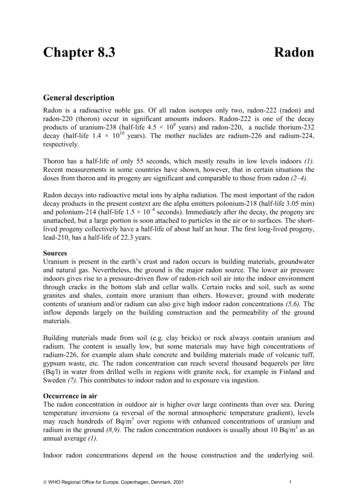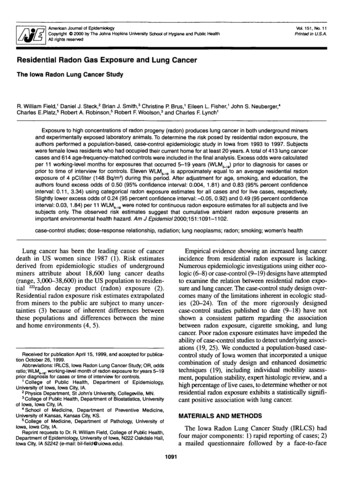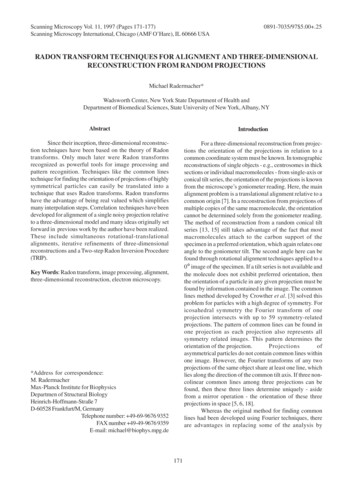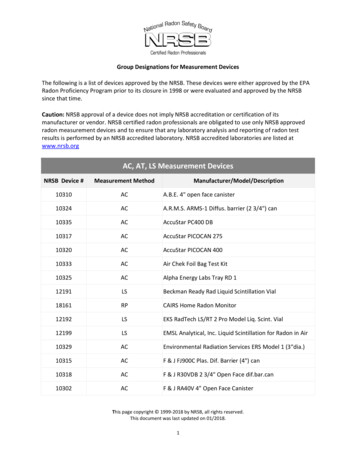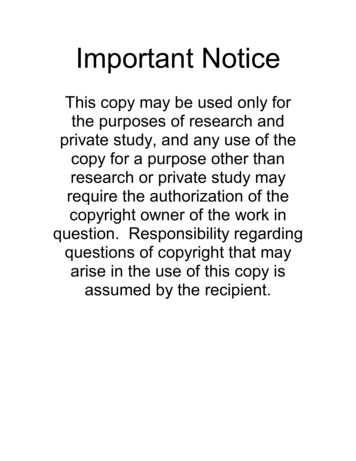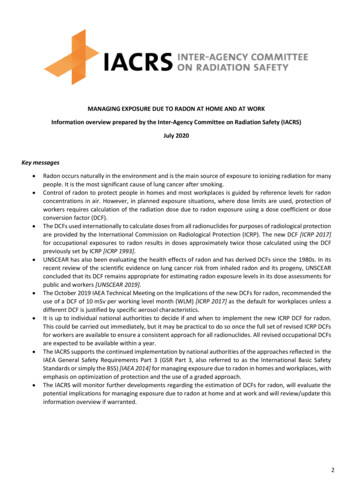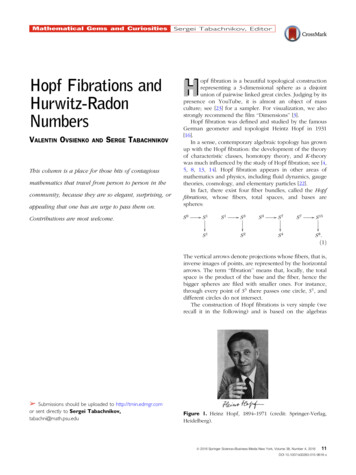
Transcription
Mathematical Gems and CuriositiesHopf Fibrations andHurwitz-RadonNumbersVALENTIN OVSIENKOANDSERGE TABACHNIKOVThis column is a place for those bits of contagiousmathematics that travel from person to person in thecommunity, because they are so elegant, surprising, orappealing that one has an urge to pass them on.Sergei Tabachnikov, Editoropf fibration is a beautiful topological constructionrepresenting a 3-dimensional sphere as a disjointunion of pairwise linked great circles. Judging by itspresence on YouTube, it is almost an object of massculture; see [23] for a sampler. For visualization, we alsostrongly recommend the film ‘‘Dimensions’’ [3].Hopf fibration was defined and studied by the famousGerman geometer and topologist Heintz Hopf in 1931[16].In a sense, contemporary algebraic topology has grownup with the Hopf fibration: the development of the theoryof characteristic classes, homotopy theory, and K-theorywas much influenced by the study of Hopf fibration; see [4,5, 8, 13, 14]. Hopf fibration appears in other areas ofmathematics and physics, including fluid dynamics, gaugetheories, cosmology, and elementary particles [22].In fact, there exist four fiber bundles, called the Hopffibrations, whose fibers, total spaces, and bases arespheres:HContributions are most welcome.ð1ÞThe vertical arrows denote projections whose fibers, that is,inverse images of points, are represented by the horizontalarrows. The term ‘‘fibration’’ means that, locally, the totalspace is the product of the base and the fiber, hence thebigger spheres are filed with smaller ones. For instance,through every point of S 3 there passes one circle, S 1 , anddifferent circles do not intersect.The construction of Hopf fibrations is very simple (werecall it in the following) and is based on the algebrasâ Submissions should be uploaded to http://tmin.edmgr.comor sent directly to Sergei Tabachnikov,tabachni@math.psu.eduFigure 1. Heinz Hopf, 1894–1971 (credit: Springer-Verlag,Heidelberg).Ó 2016 Springer Science Business Media New York, Volume 38, Number 4, 201611DOI 10.1007/s00283-015-9618-x
R; C; H; O; according to a famous theorem of Adams [1],there are no such fibrations in other dimensions. Note thatthe ‘‘magic’’ numbers 1, 2, 4, 8 appear twice: as thedimensions of the bases, and also, this time shifted by 1, asthe dimensions of the fibers.This note, based on the work [17], concerns a similarproblem: for which pairs (p, n), is Rn foliated by pairwiseskew affine subspaces Rp ? Two disjoint affine subspaces arepairwise skew if they do not contain parallel lines.1 In otherwords, we consider fiber bundlesð2ÞFigure 2. Adolf Hurwitz, 1859–1919, and Johann Radon,1887–1956 (both photographs: public domain).with pairwise skew affine fibers. We call them affine Hopffibrations. We shall give an answer in terms of the HurwitzRadon function that appeared in topology in the theoremof Adams [2] about vector fields on spheres.The reason for considering such ‘‘skew’’ foliations istwofold. On the one hand, the central projection of a Hopfbundle from a sphere to Euclidean space yields such afoliation. And, on the other hand, without the skewrestriction, the problem is trivial: for any p \ n, one canfoliate Rn by parallel copies of Rp .The Hurwitz-Radon Function1; 2; 4; 8; 9; 10; 12; 16; 17; 18; 20; 24; 25; 26; 28; 32. . .is known (A003485, in the Sloane encyclopedia of integralsequences [21]) as the Hurwitz-Radon function evaluatedat powers of 2. Namely, the Hurwitz-Radon function q :N ! N is defined as follows. Every natural number N canbe written as N ¼ 2n ð2m þ 1Þ, and the function q dependsonly on the dyadic part of N, that is,qðN Þ ¼ qð2n Þ;and8 2n þ 1;qðN Þ ¼ 2n; :2n þ 2;n 0mod 4n 1; 2 mod 4n 3mod 4:The numbers N ¼ 1; 2; 4; 8 are the only numbers forwhich qðN Þ ¼ N . The aforementioned formula can beequivalently written asqð2nþ4 Þ ¼ qð2n Þ þ 8;which is easier to remember.The History of the Hurwitz-Radon FunctionThe Hurwitz-Radon function was discovered around 1920,independently, by Adolf Hurwitz and Jean Radon [12, 18]2.Both were working on the problem of ‘‘square identities,’’2ða21 þ þ a2r Þðb21 þ þ b2s Þ ¼ c21 þ þ c2N ;where c1 ; . . .; cN are bilinear forms in a1 ; . . .; ar andb1 ; . . .; bs with real coefficients. The above identity is said tobe of size [r, s, N].For example, a formula of size [4, 4, 4] is Euler’s foursquare identityða21 þ a22 þ a23 þ a24 Þðb21 þ b22 þ b23 þ b24 ÞThe sequence1or composition of quadratic forms, that is, formulas of thetype¼ ða1 b1 þ a2 b2 þ a3 b3 þ a4 b4 Þ2þ ða1 b2 a2 b1 þ a3 b4 a4 b3 Þ2þ ða1 b3 a2 b4 a3 b1 þ a4 b2 Þ2þ ða1 b4 þ a2 b3 a3 b2 a4 b1 Þ2 :that corresponds to multiplication of quaternions. Euler’sidentity is nothing other than the property jajjbj ¼ jabj inH. It was discovered by Leonhard Euler in 1748, almost ahundred years before the discovery of quaternions. Notealso that a similar formula of size [2, 2, 2], that correspondsto multiplication of complex numbers, was known toDiophantus, and also appeared in the early VII century in abook of an Indian mathematician Brahmagupta; Fibonaccialso used it in his ‘‘Book of Squares.’’ There exists also asquare identity of size [8, 8, 8], found by a Dutch mathematician Ferdinand Degen in 1818, that corresponds tomultiplication of octonions.In 1898, Hurwitz proved his famous 1, 2, 4, 8 theorem,stating that a square identity of size [N, N, N] can exist onlyfor n 2 f1; 2; 4; 8g. This is equivalent to the statement thatR; C; H; O are the only real normed division algebras withunit. He also formulated a problem to characterize tripletsr; s; N 2 N for which there exists a square identity of size[r, s, N]. This problem remains wide open. Traditionallyconsidered as a problem of number theory, it plays animportant role in many other areas of mathematics; formore details see [20].Note that if n-dimensional space admits pairwise skew p-dimensional subspaces, then n 2p þ 1.The paper of Hurwitz was published posthumously.12THE MATHEMATICAL INTELLIGENCER
Hurwitz and Radon proved that a formula of size[r, N, N] exists if and only if r qðN Þ, and this is still theonly case in which the Hurwitz problem is solved.The Hurwitz-Radon function later appeared, sometimesunexpectedly, in many different areas, such as algebra, representation theory, geometry, topology, and combinatorics.The function gives the dimension of irreducible representations of Clifford algebras that are important in mathematicsand physics. The Hurwitz-Radon function appeared in thecontext of multiantennas’ wireless communication.The ‘‘exceptional’’ numbers 1, 2, 4, 8 (or 0, 1, 3, 7) oftenappear in mathematics and physics. The best-known subjects are: the celebrated results of topology aboutparallelizable spheres and Hopf fibrations, and the famoustheorem of algebra about classification of real normeddivision algebras. In these subjects, the above numbersappear as the critical dimensions.The Adams Theorem about Vector Fields on SpheresThe theorem of Adams [2] is perhaps the best known, and itis one of the most beautiful applications of the HurwitzRadon function.Figure 3. The Hopf link: two fibers of the Hopf fibration.Adams’s theorem generalizes the theorem that thespheres S 0 ; S 1 ; S 3 , and S 7 are the only parallelizable3spheres. This was proved independently in 1958 by Kervaire [15] and by Bott and Milnor [6].The Classical Hopf FibrationsThe Hopf Fibration of S3The fibers of the Hopf fibrationTHEOREM 1. The maximal number of vector fields on thesphere S N 1 , linearly independent at each point, isqðN Þ 1.The existence part of this theorem follows from theHurwitz-Radon construction of square identities. Supposethat we have a square identity of size [r, N, N]. Consider theN-vector c ¼ ðc1 ; . . .; cN ÞT . Since every ci is a bilinear formin a’s and b’s, we have:0 1b1B . CBð3Þc ¼ ða1 A1 þ þ ar Ar Þ@ . CA;bNwhere A1 ; . . .; Ar are N N matrices with real coefficients.The existence of a square identity implies that, for every . . .; Ar b are linearlynonzero b 2 RN , the vectors A1 b;independent, that is, that c 6¼ 0 in (3) whenever a 2 Rr isnonzero. Indeed, the right-hand side of the square identityis the square of the norm of c , whereas the left-hand side is the product of the squares of the norms of a and b.Therefore, the existence of a square identity of size[r, N, N] guarantees the existence of r (linear) vector fieldsin RN f0g, linearly independent at each point. To obtain(at least) r 1 independent vector fields on S N 1 , one nowrestricts the constructed r fields to the round sphere andprojects to its tangent plane.Let us mention that the existence part of the Adams theorem was known since the 1920s; the converse statement isone of the most difficult results of algebraic topology.are obtained by the action of S 1 , the group of complexnumbers with unit absolute values, in the complex planeC2 . The action is given by the formula e i/ ðz1 ; z2 Þ ¼ e i/ z1 ; e i/ z2 :Restricting this action to the unit sphere S 3 C2 given bythe equationjz1 j2 þ jz2 j2 ¼ 1;one obtains a fibration of S 3 by circles.Equivalently, one may consider the projection C2 f0g ! CP1 that sends a point of the complex plane to theline through this point and the origin. In coordinates,ðz1 ; z2 Þ 7! ðz1 : z2 Þ:Restricting this projection to S 3 C2 , and noticing thatCP1 ’ S 2 , the Riemann sphere, one obtains the Hopffibration.Let us mention three properties of the Hopf fibration:(1) every two fibers of the Hopf fibration are linkednontrivially (see Fig. 3);(2) every fiber is a great circle in S 3 ;(3) these great circles are equidistant from each other.3Parallelizability of a manifold means that it admits as many vector fields linearly independent at each point as its dimension. Examples of parallelizable manifolds areLie groups.Ó 2016 Springer Science Business Media New York , Volume 38, Number 4, 201613
Higher-Dimensional Hopf FibrationsThe construction of the Hopf fibration of S 3 has twoimmediate generalizations.Let us replace the algebra of complex numbers C by theother division algebras, R; H, and O. The projections fromthe quaternionic and octonionic planes to the respectiveprojective lines, H2 f0g ! HP1 and O2 f0g ! OP1 ,are defined as in the complex case. Restricted to thespheres S 7 H2 and S 15 O2 , these projections give riseto the following fibrationsPCFigure 4. The stereographic projection and the central projection: conformal geometry vs projective geometry.whose fibers are S 3 and S 7 , respectively (the quaternionsand octonions of absolute value 1). Note that HP1 ’ S 4 andOP1 ’ S 8 since these are quaternionic and octonionic linescompleted by one point at infinity.4 Finally, replacing C byR, one obtains the fibration S 0 ! S 1 ! RP1 whose fibersconsist of two points. This provides a complete list of Hopffibrations (1).Another straightforward generalization of the Hopffibration is obtained by replacing the plane by ðm þ 1Þdimensional complex vector space. Consider the action ofS 1 in Cmþ1 given by e i/ ðz1 ; z2 ; . . .; zmþ1 Þ ¼ e i/ z1 ; e i/ z2 ; . . .; e i/ zmþ1 :Restricting this action to the sphere S 2mþ1 Cmþ1 , oneobtains a fibration of S 2mþ1 by S 1 . The base of this fibrationis the complex projective space CPm .The same construction can be applied in the quaternionic cases, replacing S 1 by the unit sphere S 3 H. Oneobtains three infinite series of fibrations:the circles that pass through P: they are sent to straightlines.An equally important projection from the n-dimensionalsphere to the n-dimensional Euclidean space is the centralprojection. It projects the sphere S n Rnþ1 , with theequatorial sphere S n 1 removed, from the center C of thesphere to an affine space Rn Rnþ1 that does not passthrough the origin. The central projection sends great circles to straight lines, and great spheres to affine planes.The image of the Hopf fibration of S 3 under thestereographic projection is a beautiful geometric structurein R3 called the Villarceau circles. These circles foliate R3with a straight line removed (this line is the stereographicimage of the Hopf circle through point P). See Figures 5and 6.The image of the Hopf fibration of S 3 under the centralprojection is a fibration of R3 by lines; see Figure 7. Theselines are pairwise skew: two parallel lines ‘‘intersect’’ atinfinity, and their preimages in S 3 are great circles thatintersect at a point on the equator.EXAMPLE 2.1. The central projections of the fibrations (1)ð4ÞThis construction does not work in the octonionic case, andthe fibration with fibers S 7 ! S 15 ! S 8 remains exceptionaland does not belong to any series.It is still true that every fiber of a fibration (4) is a greatsphere.Projection to Euclidean SpacesThe usual way to ‘‘visualize’’ the Hopf fibration is by way ofprojecting them to the Euclidean spaces.The stereographic projection is ubiquitous. This mapidentifies the sphere with one point, the North Pole P,deleted, with n-dimensional Euclidean space (the tangentspace at the South pole); see Figure 4. The main property ofthe stereographic projection is that this is a conformal map:it preserves the angles. It sends circles to circles, except forand (4) give fibrations of the Euclidean space by pairwiseskew affine subspaces:Affine Hopf FibrationsLet us consider the affine Hopf fibrations (2) in fullgenerality.Existence Theorem and First ExamplesThe problem of describing all pairs (p, n) for which suchfibrations exist was solved in [17].5THEOREM 2. Rn admits a fibration by p-dimensionalpairwise skew affinep qðn pÞ 1:subspacesifandonlyifSee [7] concerning octonions and OP1 .The next step would be a classification of affine Hopf fibrations. See [10, 19] for partial results. A classification of fibrations of S 3 by great circles was obtained by H. Gluck andF. Warner [9]: they are in one-to-one correspondence with distance-decreasing self-maps of a 2-sphere.4514THE MATHEMATICAL INTELLIGENCER
01a1B . CCc ¼ ðb1 B1 þ þ bN BN ÞB@ . A;arwhere B1 ; . . .; BN are N r matrices with real coefficients.Using the notation :¼ b1 B1 þ þ bN BN ;BðbÞFigure 5. A key-ring model of Villarceau circles (WikimediaCommons). is of maximal rankthe square identity implies that BðbÞ(i.e., of rank r) for all b 6¼ 0. This matrix expression is ofcourse equivalent (actually, dual) to (3).Furthermore, using a linear change of coordinatesðb1 ; . . .; bN Þ, we can assume that the last column of eachmatrix Bi is the vector ð0; . . .; 0; 1; 0; . . .; 0ÞT with 1 at ithposition. Let Bi0 denote the N ðr 1Þ matrix Bi with thelast column removed, and let 0 :¼ b1 B0 þ þ bN B0 :BðbÞ1NOur construction follows. Consider the direct productRN Rr 1 ’ RN þr 1 ;Figure 6. Villarceau circles and skew lines at Musée del’Oeuvre Notre-Dame, Strasbourg (photograph by LubaShenderova-Fock).with RN being understood as the ‘‘vertical,’’ and Rr 1 as the‘‘horizontal’’ subspace; the coordinates on these spaces aredenoted by y ¼ ðy1 ; . . .; yN Þ and x ¼ ðx1 ; . . .; xr 1 Þ, respectively. At every point b 2 RN , consider the affine ðr 1Þdimensional subspace of RN þr 1 through b defined by 0 x þ b:y ¼ BðbÞIt follows from the maximality of the rank that any two ofthese affine spaces are skew, and we obtain an affine Hopffibration on RN þr 1 .Next we give geometric arguments for the nonexistence. Consider the first example after dimension three,that of R4 .EXAMPLE 3.1. The space R4 has no affine Hopf fibrations.Indeed, the only affine subspaces of R4 that can be pairwise skew are 1-dimensional. However, if p ¼ 1, thenn p ¼ 3 is odd, so qðn pÞ ¼ 1. The condition of Theorem 2 is not satisfied. The same holds true for all spaces ofndimension 2k , that is, the space R2 admits no affine Hopffibrations.Figure 7. ‘‘Nested hyperboloids’’ by David Eppstein (from theWikipedia article ‘‘Skew Lines’’).The condition of this theorem is satisfied in Examples2.1. Indeed, if p ¼ 1 and n ¼ 2m þ 1, then n p is even, sothat qðn pÞ 2. If p ¼ 3 and n ¼ 4m þ 3, then n p is amultiple of 4, so that qðn pÞ 4. Finally, if p ¼ 7 andn ¼ 15, then qðn pÞ ¼ 8.Let us sketch the proof of Theorem 2. The existence partis, again, a consequence of the Hurwitz-Radon construction. Given a square identity of size [r, N, N], rewrite thevector of bilinear forms c ¼ ðc1 ; . . .; cN ÞT of the right-handside in the following formFor the proof, consider first R3 equipped with thefibration depicted in Figure 7. Choose any fiber, sayvertical, and a 2-dimensional plane orthogonal to it.Draw a circle around the point of intersection of theplane and the fiber. Pick any point x of the circle andconsider the unit vector that belongs to the fiberthrough x. Project this vector to the tangent line of thecircle (the projection goes in two steps: first project tothe horizontal plane, then to the tangent); see Figure 8.Since the fiber through x is skew with the vertical line,the projection is nonzero.Assume now that R4 is fibered by pairwise affine lines.Exactly the same construction would then give aÓ 2016 Springer Science Business Media New York , Volume 38, Number 4, 201615
More generally, a remarkable series of affine Hopf fibrations corresponds to the following dimensions:ð p; n pÞ ¼ ðqð2n Þ 1; 2n Þ:None of them is a projection of a classical Hopf fibration.Figure 8. Affine Hopf fibrations and vector fields on spheres.nonvanishing vector field on a 2-dimensional sphere thatlies in a 3-dimensional affine subspace, orthogonal to afiber. This, however, contradicts the famous hairy balltheorem: S 2 does not admit a nonvanishing continuoustangent vector field. It follows that R4 admits no affineHopf fibrations.A similar argument is used to deduce the ‘‘necessary’’part of Theorem 2 from Theorem 1.In fact, Theorem 2 extends to a semilocal result: itsassertion holds for fibrations by pairwise skew affine subspaces of a neighborhood of a single fiber.EXAMPLE 3.2. Let us now consider p ¼ 8 and n ¼ 24.Since qð16Þ ¼ 9, the condition of Theorem 2 is satisfied.We therefore have an affine Hopf fibration of R24 with 8-dimensional fibers. This is the first example of an affineHopf fibration that does not come from a projection of aclassical Hopf fibration.16THE MATHEMATICAL INTELLIGENCERA TableThe condition of Theorem 2 is implicit (since p appears inboth parts of the inequality). Therefore, for a given n, thesituation has to be analyzed.Consider the cases of n 80. The dimensions(p, n) for which affine Hopf fibrations of Rn with pdimensional fibers exist are presented in the following tables.Recall the semilocal extension of Theorem 2. It impliesthat, given a (local) (p, n) affine Hopf fibration, the intersection with a hyperplane transverse to the fibers yields a(local) ðp 1; n 1Þ affine Hopf fibration. This leads to thenotion of a dominant (p, n) affine Hopf fibration: it is thecase when a ðp þ 1; n þ 1Þ affine Hopf fibration does notexist. In the table that follows, the dominant pairs (p, n) areshown in boldface.The fibrations with n ¼ 3; 7; 15 are the central projections of the Hopf fibrations. The next values are asfollows.including two interesting cases: ðp; nÞ ¼ ð8; 24Þ and(7, 31). The next values are:
We see another example of an interesting ‘‘non-Hopf’’ fibration: R9 ! R41 ! R32 . The next values are as follows.andWe observe several more non-Hopf fibrations with relatively large fibers.Another observation is that some of the spaces admit nofibrations with skew fibers at all. In addition to the caseswhen the dimension is a power of 2, this happens for R80 .The Complex CaseThe definition of affine Hopf fibrations in Cn is exactly thesame as in the real case. Surprisingly, the problem is muchmore difficult in this case, and it seems not to be reducibleto linear algebra.Only necessary conditions are known for the existenceof complex affine Hopf fibrations. It was proved in [10] thatan affine Hopf fibration of Cn with fibers of dimension pmay exist only if, for each integer r with 0 r p, thecoefficients of t r in the power series expansion of n ptlnð1 þ tÞis an integer.The minimal dimension n, considered as a function of p,grows very quickly. For example, for a complex skewfibration with 1-dimensional fibers, the ambient space is atleast 3-dimensional (like in the real case), but for 2-dimensional fibers, the ambient dimension is not less than 26,and for 4-dimensional fibers, the ambient dimension is notless than 2884.Valentin OvsienkoCNRSLaboratoire de MathématiquesUniversité de Reims-Champagne-ArdenneFR 3399 CNRS51687, ReimsFrancee-mail: valentin.ovsienko@univ-reims.frSerge TabachnikovDepartment of MathematicsPennsylvania State UniversityUniversity Park, PA 16802USAe-mail: tabachni@math.psu.eduREFERENCES[1] J. F. Adams, On the nonexistence of elements of Hopf invariantone, Ann. of Math. 72 (1960), 20–104.[2] J. F. Adams, Vector fields on spheres, Ann. of Math. (2) 75 (1962),603–632.[3] A. Alvarez, J. Leys, E. Ghys, Film ‘‘Dimensions,’’ http://www.dimensions-math.org.[4] M. F. Atiyah, K-theory. Notes by D. W. Anderson. Second edition.Addison-Wesley, Redwood City, CA, 1989.[5] R. Bott, Lectures on K ðXÞ, W. A. Benjamin, 1969.ACKNOWLEDGMENTS[6] R. Bott, J. Milnor, On the parallelizability of the spheres, Bull.We are grateful to D. B. Fuchs, M. Harrison, and S. MorierGenoud for enlightening discussions, and to L. ShenderovaFock for a nice picture. The second author was partially supported by the NSF grants DMS-1105442 and DMS-1510055.Amer. Math. Soc. 64 (1958), 87–89.[7] J. Conway, D. Smith. On quaternions and octonions: theirgeometry, arithmetic, and symmetry. A. K. Peters, Ltd., Natick,MA, 2003.Ó 2016 Springer Science Business Media New York , Volume 38, Number 4, 201617
[8] H.-D. Ebbinghaus, H. Hermes, F. Hirzebruch, M. Koecher,[17] V. Ovsienko, S. Tabachnikov, On fibrations with flat fibres, Bull.K. Mainzer, J. Neukirch, A. Prestel, R. Remmert, Numbers. Graduate Texts in Mathematics, 123, Springer-Verlag, New York, 1991.London Math. Soc., 45 (2013), 625–632.[18] J. Radon, Lineare scharen orthogonale Matrizen, Abh. Math.[9] H. Gluck, F. Warner, Great circle fibrations of the three-sphere,Duke Math. J. 50 (1983), 107–132.[10] M. Harrison, Skew flat fibrations, Math. Z., First online: 22September 2015, arXiv:1412.8448.[11] A. Hurwitz, Über die Komposition der quadratischen Formen vonSem. Univ. Hamburg 1 (1922) 1–14.[19] M. Salvai, Global smooth fibrations of R3 by oriented lines, Bull.Lond. Math. Soc. 41 (2009), 155–163.[20] D. Shapiro, Compositions of quadratic forms. Walter de Gruyter,Berlin, 2000.beliebig vielen Variablen, Nahr. Ges. Wiss. Göttingen (1898), 309–316.[21] N. J. A. Sloane, The Online Encyclopedia of Integer Sequences,[12] A. Hurwitz, Über die Komposition der quadratischen Formen,Math. Ann. 88 (1922), 1–25.https://oeis.org.[22] H. K. Urbantke, The Hopf fibration—seven times in physics, J.[13] D. Husemoller, Fibre bundles. Third edition. Springer-Verlag, NewYork, 1994.Geom. Phys., 46 (2003), 125–150.[23] https://www.youtube.com/watch?v P3k4DaRu9vs[14] M. Karoubi, K-theory, an introduction, Springer, Berlin, 1978.https://www.youtube.com/watch?v AKotMPGFJYk[15] M. Kervaire, Non-parallelizability of the n-sphere, n [ 7, Proc.https://www.youtube.com/watch?v hco2TnXR7owNat. Acad. U.S.A. 44 (1958), 280–283.[16] H. Hopf, Über die Abbildungen der dreidimensionalen Sphäre aufdie Kugelfläche, Mathematische Annalen 104 (1931), 637–665.18THE MATHEMATICAL INTELLIGENCERhttps://www.youtube.com/watch?v xWqckpDvX78https://www.youtube.com/watch?v zIx2Y5SxnTchttps://www.youtube.com/watch?v fX8DjVKD2No.
12 THE MATHEMATICAL INTELLIGENCER. Hurwitz and Radon proved that a formula of size [r, N, N] exists if and only if r qðNÞ, and this is still the only case in which the Hurwitz problem is solved. The Hurwitz-Radon function later appeared, sometimes une
